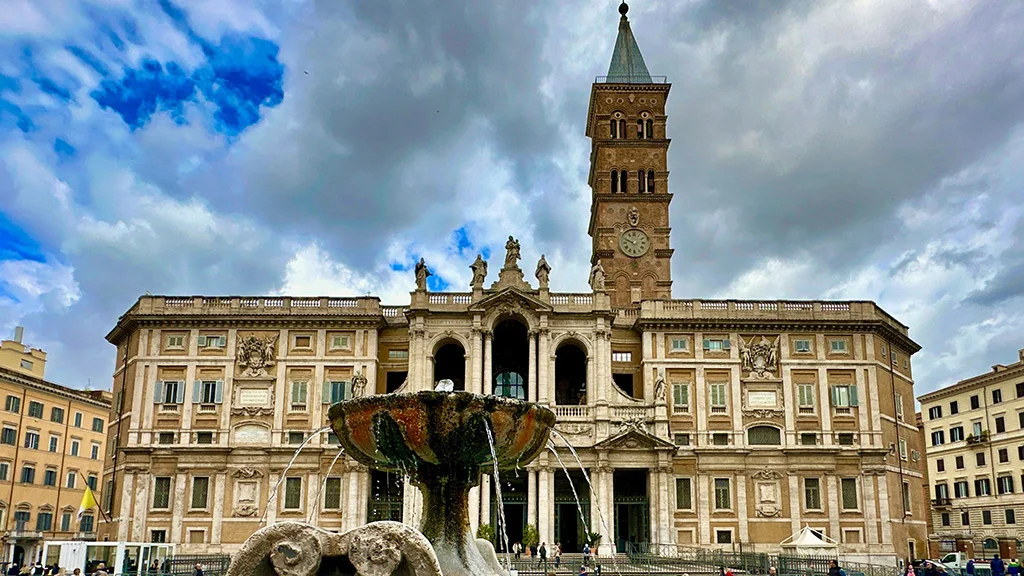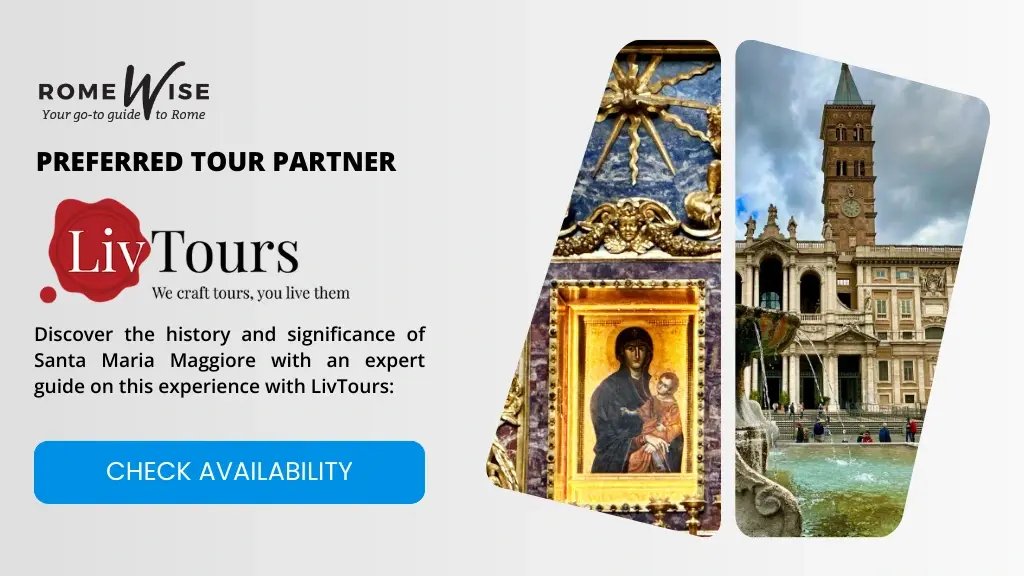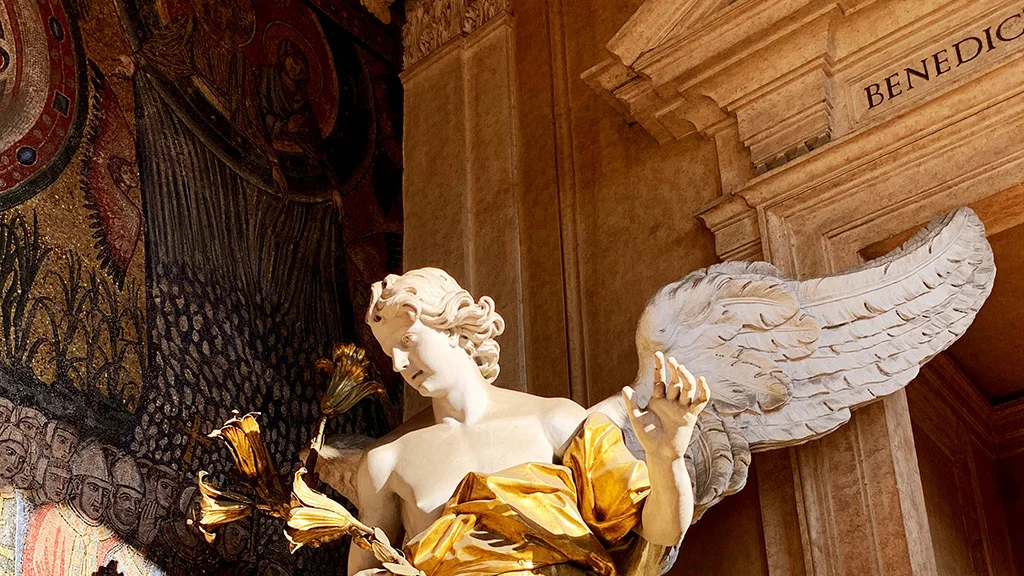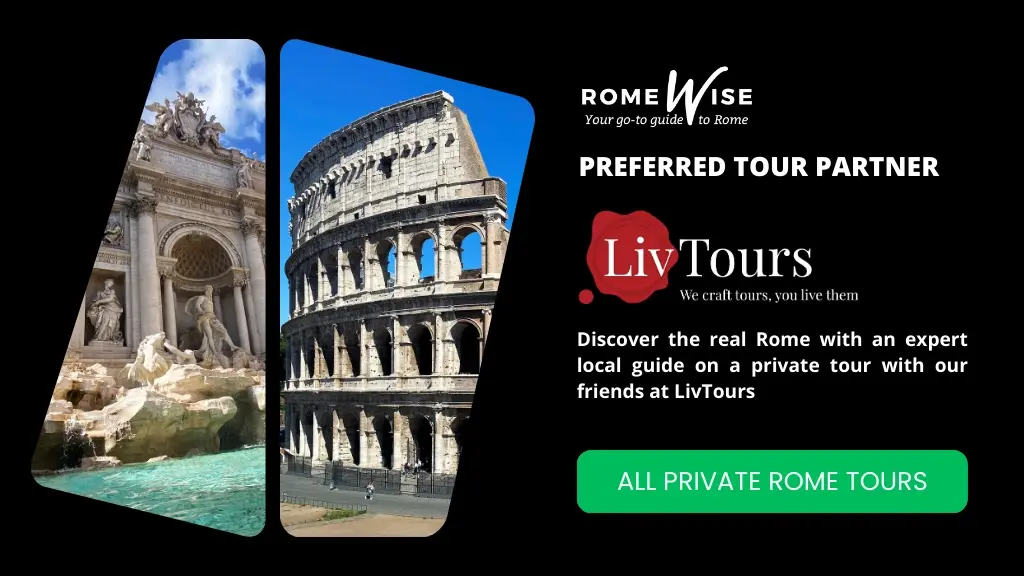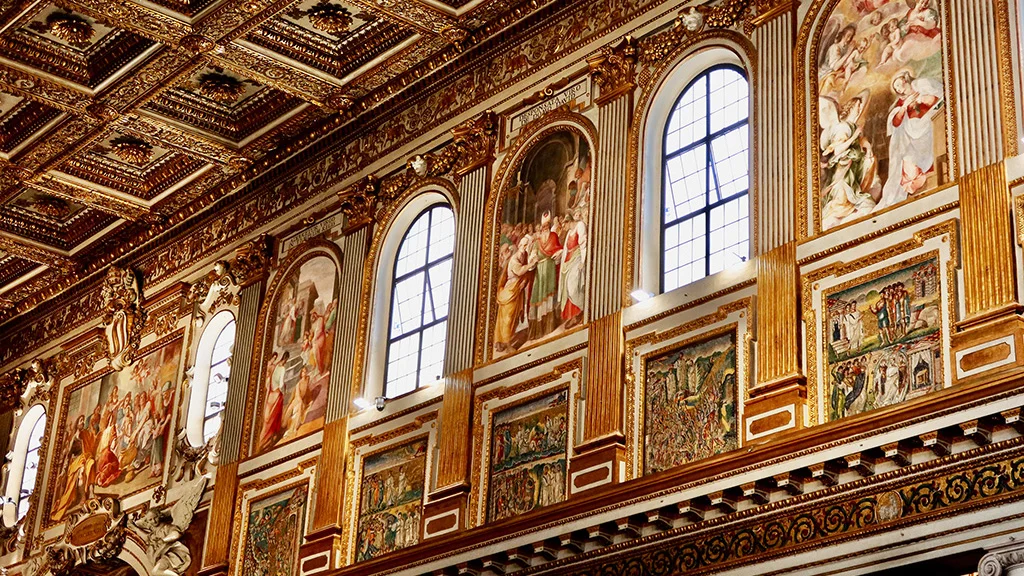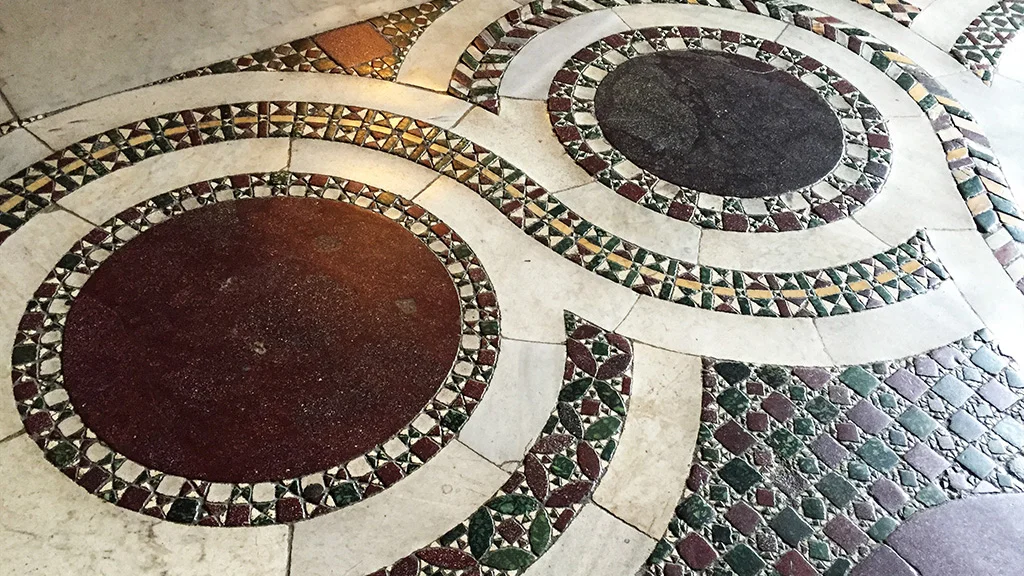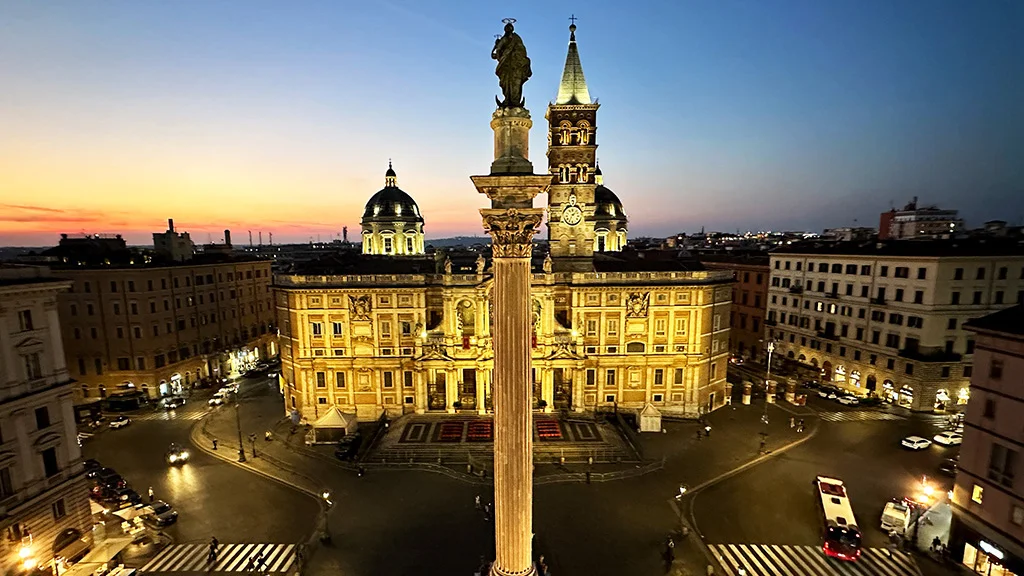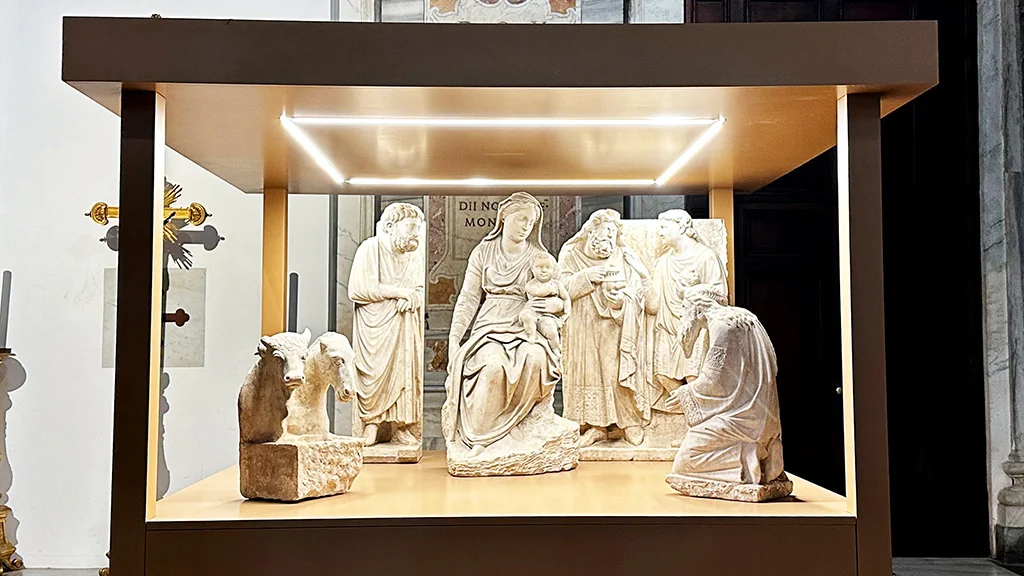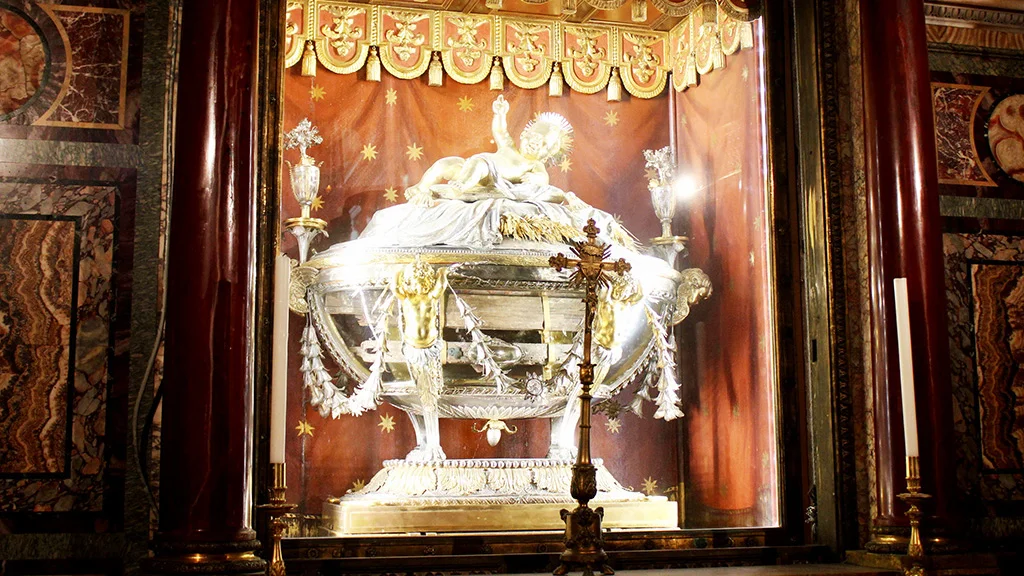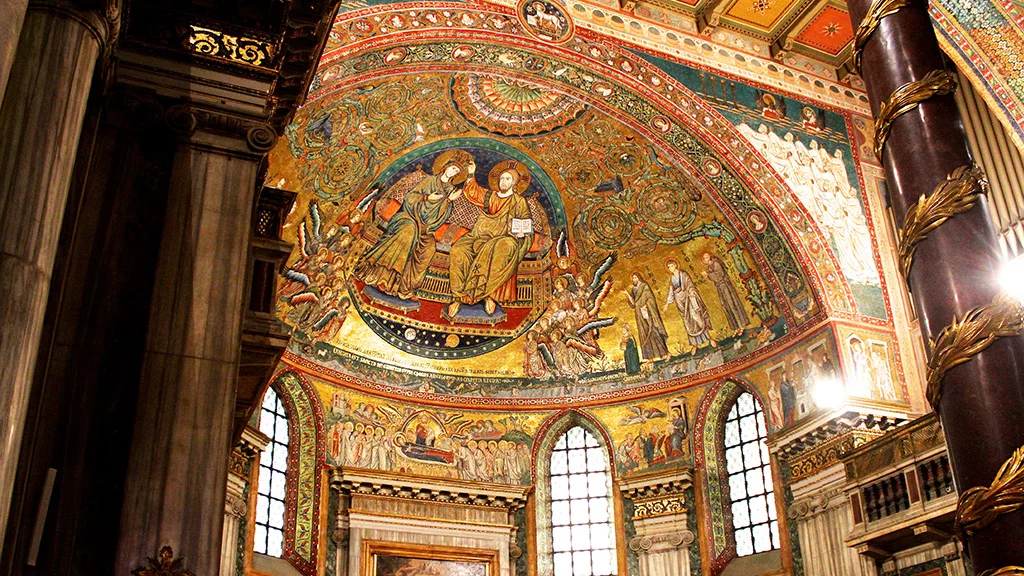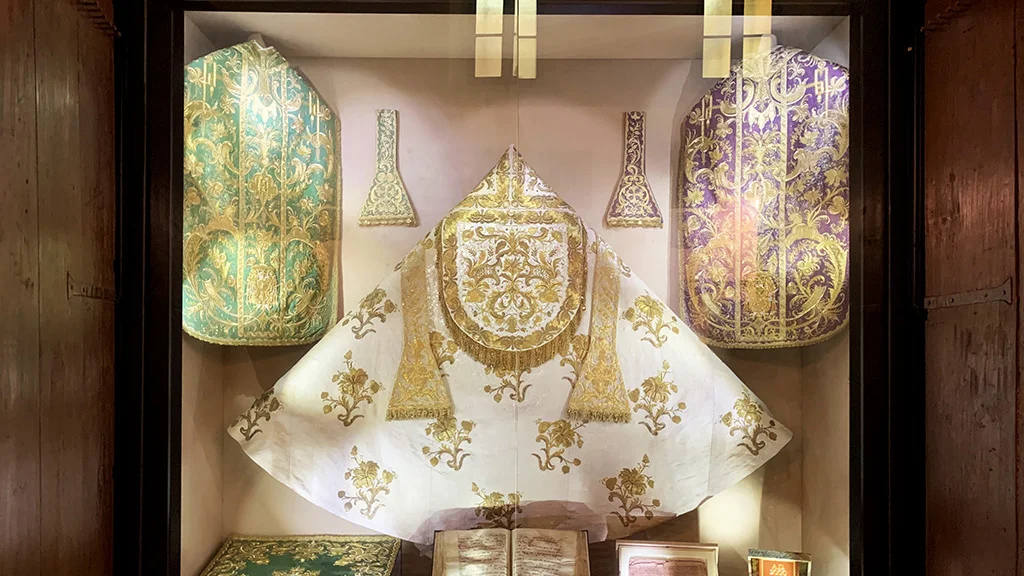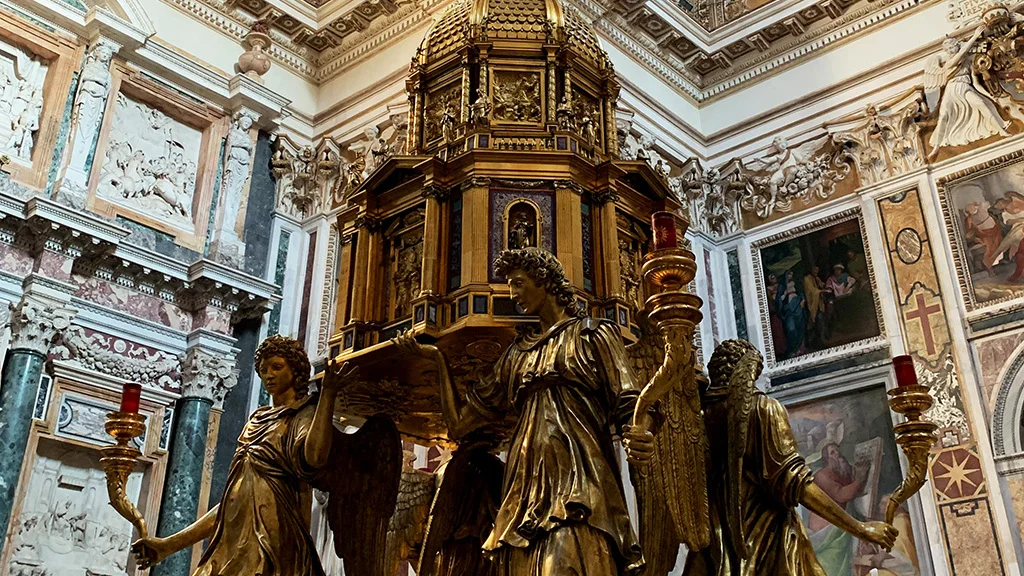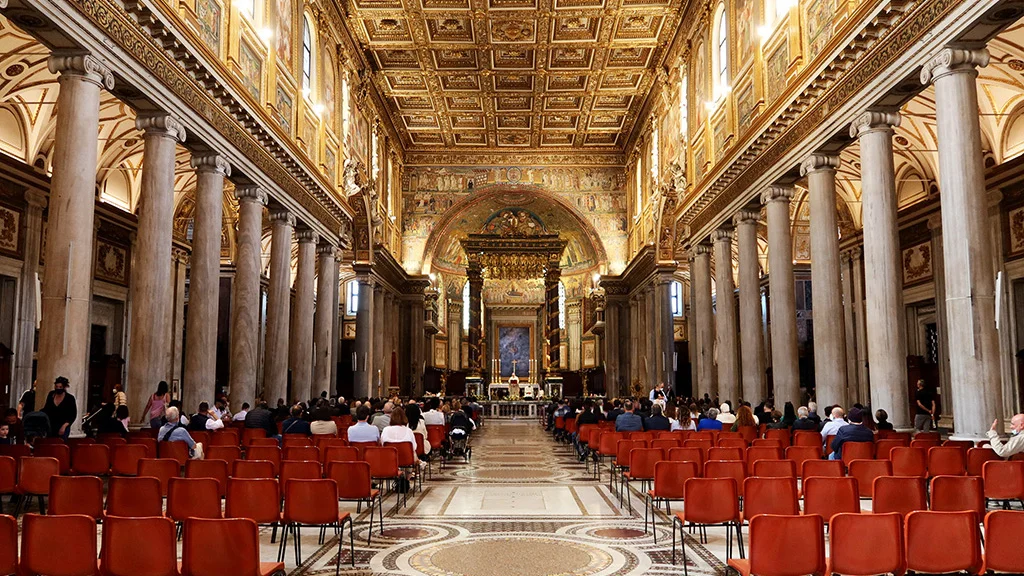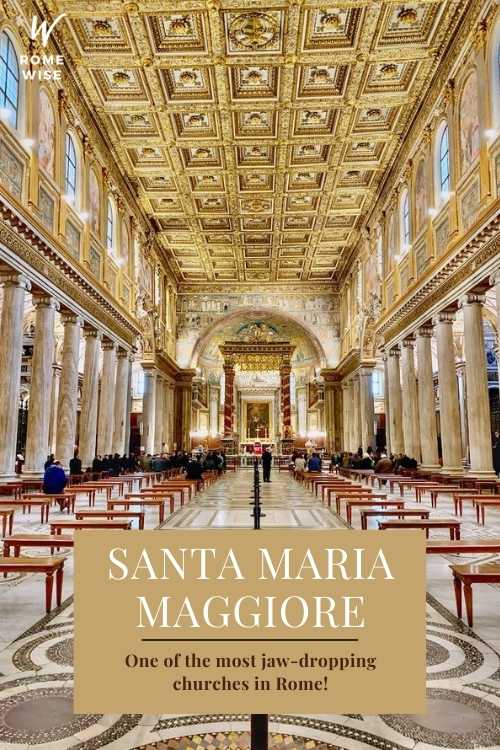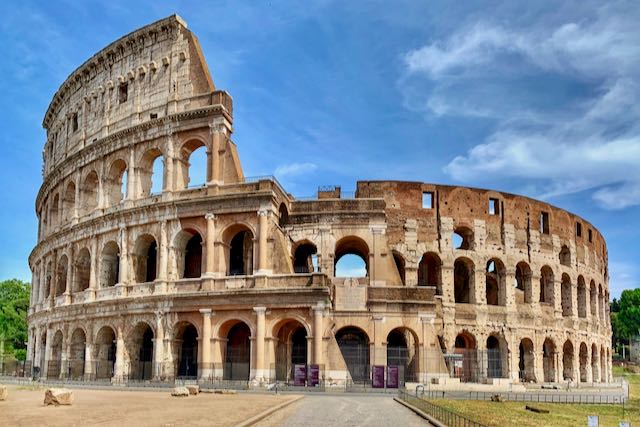- Sign up & get a FREE ebook Subscribe NOW!
- Romewise Home Page
- What to Do in Rome
- Santa Maria Maggiore Rome
The Basilica of Santa Maria Maggiore Rome - The Final Resting Place of Pope Francis
The Basilica of Santa Maria Maggiore Rome should absolutely be on your list of must-see churches.
Not (only) because it's the largest church in Rome dedicated to the Virgin Mary.
Or because of its 5th century mosaics.
Or for its golden ceiling.
It has always been one of my favorite churches in Rome, but with the addition of the late Pope Francis' tomb, Santa Maria Maggiore is even more important.
Pope Francis and Santa Maria Maggiore
On April 21 2025, Pope Francis sadly passed away. He had a special connection with this basilica and wished to be laid to rest here.
After Pope Francis' funeral on Saturday April 26, his coffin was brought to Santa Maria Maggiore to rest in his tomb.
The tomb is simple and unadorned in line with his wishes, but will nonetheless be visited by many people in the coming weeks and months.
You can expect there to be much higher visitor numbers than normal because of this, so be prepared for potential queues and changes to your visit.
Everything You Need to Know About Visiting Santa Maria Maggiore Rome
The Papal Basilica of Santa Maria Maggiore has always been one of Rome's most important churches.
With a history stretching back to the 5th century and the location for many important events over the centuries, the basilica is justifiably lavish.
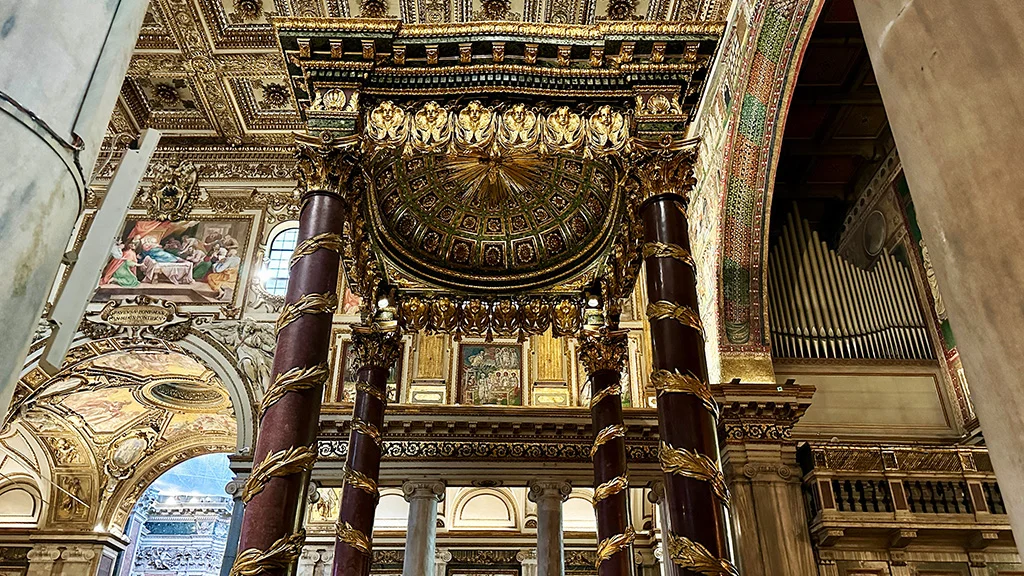 The gorgeous gold details all over the basilica are testament to the importance of Santa Maria Maggiore over the centuries
The gorgeous gold details all over the basilica are testament to the importance of Santa Maria Maggiore over the centuriesWhether you are on a religious pilgrimage, or just looking for some of the beauty and history this city has to offer, Santa Maria Maggiore should be on your travel itinerary.
To learn more and help plan your trip, in this guide I'll be covering:
- Why Santa Maria Maggiore Rome is important
- A brief history of Santa Maria Maggiore
- The architecture and interior design
- The special things to see and do at Santa Maria Maggiore
- Notable burials and chapels in Santa Maria Maggiore, including Pope Francis
- Opening hours and mass times
- Where it is and how to get there
What is so important about Santa Maria Maggiore?
Maybe I'm partial to this church, since the more I visit it, the more I see, and the more I love.
And it's stunningly beautiful to boot.
But it really is one of the most important churches in Christianity.
Santa Maria Maggiore was founded in 432.
This was just after the Council of Ephesus of 431 which decreed that the Virgin Mary was the mother of God.
The basilica is the oldest and largest of 26 churches in Rome dedicated to the Virgin Mary (hence the name, Maggiore, or Major/Most.)
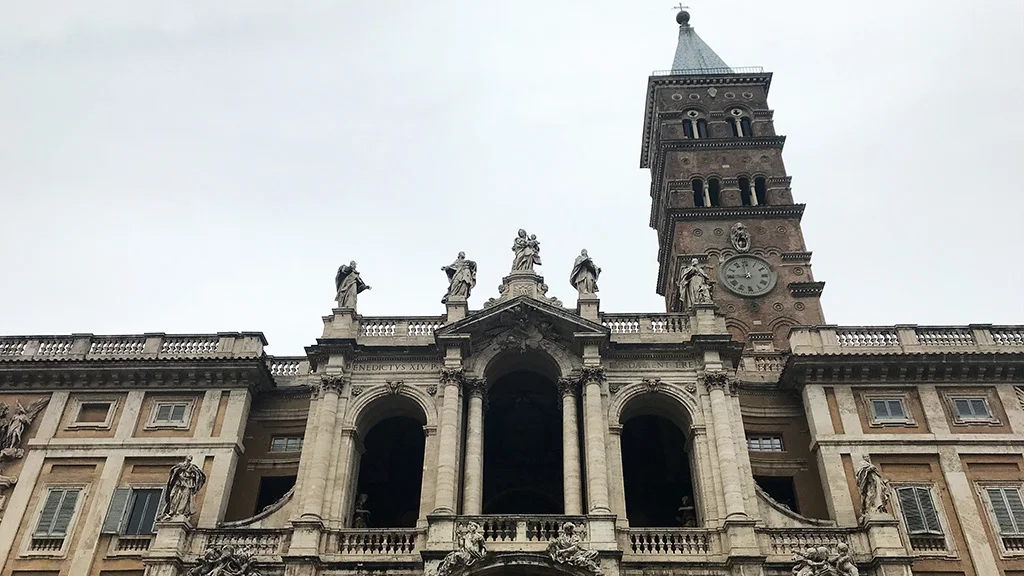 While the outside of the basilica doesn't immediately seem huge, head inside and discover how large it really is
While the outside of the basilica doesn't immediately seem huge, head inside and discover how large it really isThere is a wealth of architecture and art in the basilica that is worth seeing, whether you take it in as a whole, or decide to take a closer look.
Many of the most influential Roman families have left their mark on the basilica as well as multiple popes.
The Basilica of St Mary Major was the place to be buried, which only added to the splendor and importance of the church.
While St Peter's is of course very important and impressive, there is something distinctly Roman about St Mary Major.
The Major/Papal Basilicas
Santa Maria Maggiore is one of only four patriarchal/major basilicas, which are all in Rome.
The other three are Saint Peter's Basilica, Saint John Lateran, and Saint Paul Outside the Walls.
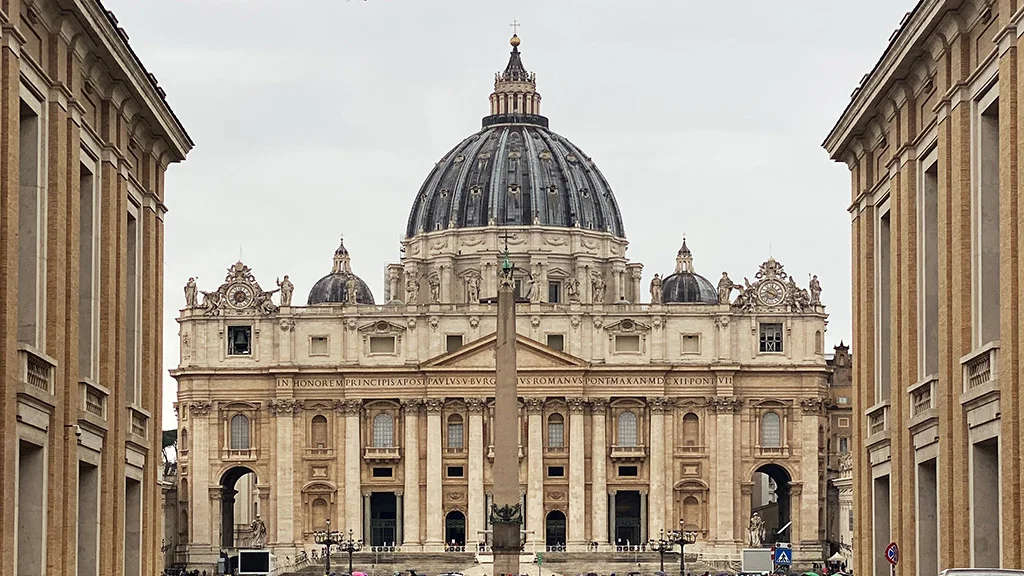 While St Peter's Basilica is the most well-known church in Rome, Santa Maria Maggiore is just as important in the city
While St Peter's Basilica is the most well-known church in Rome, Santa Maria Maggiore is just as important in the citySo what is a "Patriarchal Basilica?"
The term "Patriarchal Basilica" used to refer to basilicas ceremonially assigned to one of the Patriarchs.
Santa Maria Maggiore originally was assigned to the patriarch of Antioch.
In 2006, Pope Benedict declared the term Patriarchal Basilica to be obsolete, and now the four churches of Saint Peter, Saint John Lateran, Saint Paul Outside the Walls, and Saint Mary Major are called Papal Basilicas, or Major Basilicas.
Technically, the four major basilicas in the world are not all in Rome.
Saint Peter's basilica is in Vatican City, which is its own state.
In fact, the other three Major Basilicas, while physically "in" Rome and considered Italian territory (thanks to the Lateran Treaty of 1929), are all under the direct jurisdiction of the pope, and owned by the Vatican, something like a foreign embassy.
All the Papal basilicas, including Santa Maria Maggiore, are policed by the Vatican gendarmerie, not by Italian police.
But all the papal basilicas are easily accessible while you are visiting Rome, and you can visit all four of these basilicas in one Rome visit.
A Brief History of Santa Maria Maggiore
Stretching back to the early days of Christianity in Europe, the origins of Santa Maria Maggiore are shrouded in legend.
However we have records showing that the original structure of the church we see today was consecrated in August 434.
So how do we get from a 5th century church to the magnificent basilica today?
The Ancient Origins of Santa Maria Maggiore Rome
In 375 BCE, a temple to honor the Roman goddess Juno Lucina, was built somewhere in this area.
Its exact location is unknown so it's not clear if it was on the site where Santa Maria Maggiore is now.
Archeological excavations have revealed a 1st century building whose entrance was under the apse of today's basilica, likely the villa of a wealthy family.
The excavations show an evolution of architectural style and art, indicating that the building was amended over the next three centuries.
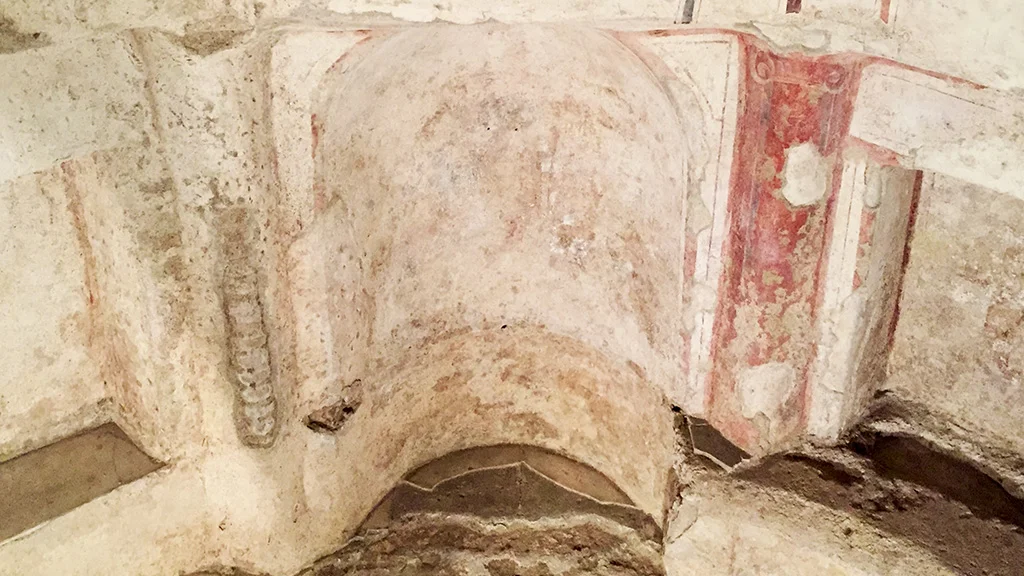 These ancient Roman frescoes date back to the 1st century, well before any church stood on this site
These ancient Roman frescoes date back to the 1st century, well before any church stood on this siteSkipping ahead to the year 352 (or 358, sources differ), we have the origin legend of the basilica.
Wealthy Roman patrician John and his wife were childless, and so vowed to donate all their possessions to the Virgin Mary.
They asked for divine intervention, asking the Virgin to tell them how she wished for them to do this.
The Virgin appeared to both John and the current pope, Liberius in their dreams, asking for the construction of a church in her name.
She told them she'd leave a miraculous sign so they would know where to honor her.
A Miraculous August Snowfall
On the night of August 5, at the peak of the notorious Roman summer heatwave, it snowed on the top of the Esquiline Hill.
The miraculous snow fell in exactly the size and shape the church was meant to have, so Pope Liberius had the shape of the new building outlined right there for him.
Named for this pope, the first church was known as the Liberian Basilica, and was paid for by John and his wife's fortune.
While this original church was replaced with the current basilica around 100 years later, the miracle of the snow is still remembered.
The basilica was referred to as 'Our Lady of the Snows' for centuries and the consecration of the new basilica was set for August 5 434 to tie the new building to the old one.
Every August 5, even today, you can visit the piazza outside Santa Maria Maggiore at around 9PM, where they simulate a snowstorm.
You can also attend Mass in the morning or Vespers in the evening, where you will see white flower petals descend from the ceiling to celebrate the original miracle.
The New Basilica
In the 5th century, the pope ordered a new church be built to honor Mary.
Her status had just been confirmed as the Mother of God and it was important for her new place in the Christian faith to be recognized.
Located on the highest point of the Esquiline Hill, one of the original seven hills of Rome, the Liberian basilica was the perfect place for the new church.
This was completely destroyed to make room for the basilica you see today, which despite the improvements made over the years, is largely the original church.
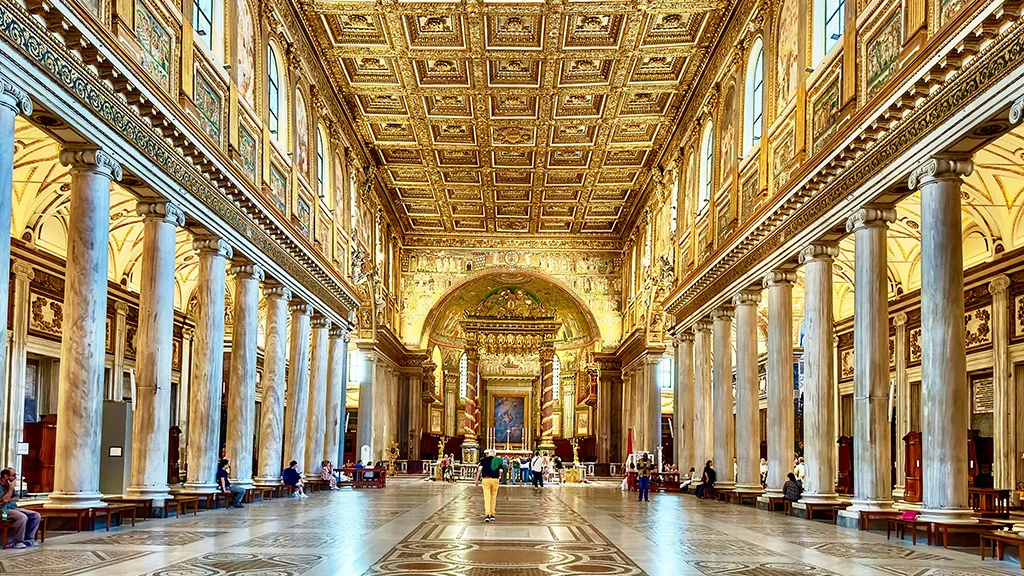 I find it absolutely amazing that this floorplan and layout is pretty much identical to the original church from over 1500 years ago!
I find it absolutely amazing that this floorplan and layout is pretty much identical to the original church from over 1500 years ago!The central nave you see as soon as you walk in is the original nave and its 5th century mosaics are original too.
This church was the first church dedicated to Mary in Rome, built much earlier than the 7th century Santa Maria Antiqua (inside the Roman Forum, near the Colosseum.)
Its original name was Sanctae Mariae.
A BASILICA BY ANY OTHER NAME...
The legend of the snowfall is one of the reasons the basilica is also called Our Lady of the Snows (La Madonna della Neve.)
It has also been called the Liberian basilica, named for Pope Liberius.
Finally, the basilica has one other name - Santa Maria ad Praesepem, because of the relics from Jesus' birth held here (see below.)
Later Changes to the Basilica
After the basilica of Santa Maria Maggiore was established, it was clear it was something special with stunning mosaics and large design.
However, over time improvements and additions were made.
In the 12th century the Cosmatesque flooring was added, and then a new apse decorated with Byzantine-style mosaics in the 13th century.
Around the same time, what is thought of as the first nativity scene was created by Arnolfo di Cambi for a new Nativity chapel and more mosaics were added to the church facade.
The Romanesque bell tower was added in the 1370's, and is still the tallest in Rome at 246 ft/75m high - although the clock wasn't installed until much more recently.
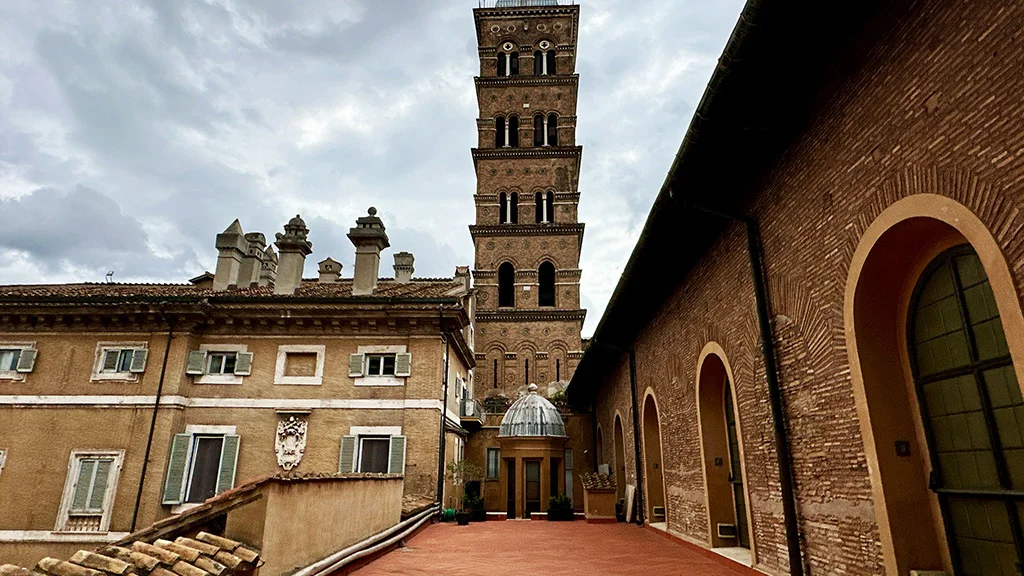 The bell tower is in a different style to the rest of the basilica, designed at a point when the Romanesque style was very popular
The bell tower is in a different style to the rest of the basilica, designed at a point when the Romanesque style was very popularFurther changes were made in the 15th and 16th centuries too; first the gold ceiling was installed and then the Sistine Chapel (no, not the famous one at the Vatican!) was built.
This was built for Pope Sixtus V as he wanted to be buried here along with his predecessor and mentor Pope Pius V.
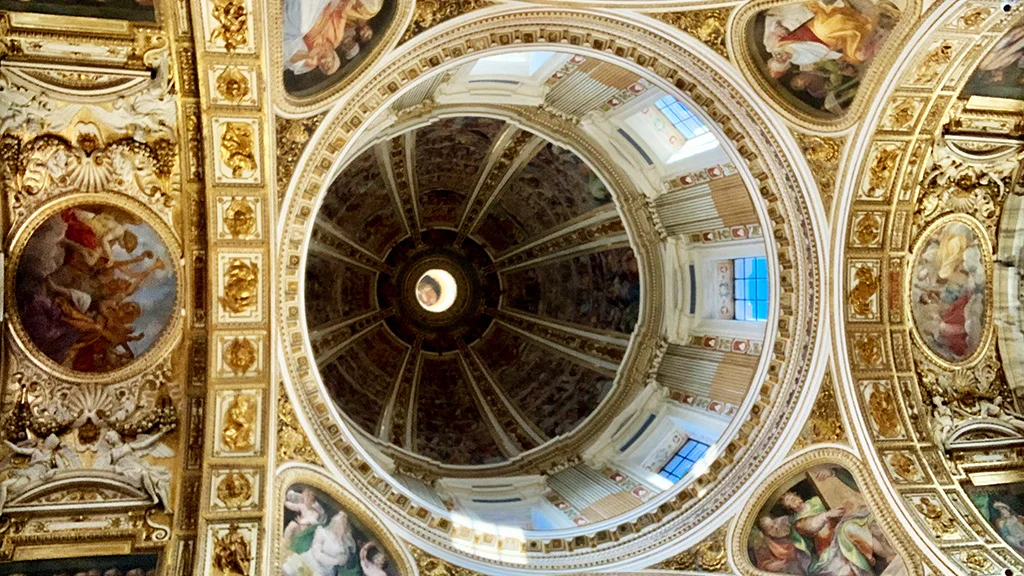 While nowhere near as famous as the Sistine Chapel in the Vatican, the ceiling and dome of this one is still very impressive
While nowhere near as famous as the Sistine Chapel in the Vatican, the ceiling and dome of this one is still very impressiveFurther chapels added through the 16th and 17th centuries include the Sforza Chapel designed by Michelangelo and the Pauline Chapel.
The Pauline Chapel was built for the Borghese Pope Paul V, but also is home to the tomb of Gian Lorenzo Bernini.
Additional minor changes have been made since, but the most recent addition is the tomb of Pope Francis.
This is located in a side nave between the Sforza Chapel and the Pauline Chapel.
Santa Maria Maggiore Architecture and Interior
In ancient Rome, basilicas were buildings that served as markets, courthouses, and meeting halls, among other things.
They had a particular form that was useful for large groups of people.
Some of these structures from ancient Rome were converted into churches, keeping the same basic concept.
Santa Maria Maggiore was built specifically to be a Christian basilica from the start, acting as a fascinating bridge from ancient Roman to early Christian architecture.
Here are some of the most interesting architectural details:
The Ceiling
One of the most recognizable elements of the basilica is the intricate ceiling.
This was only added in the 15th century.
Designed by Giuliano da Sangallo, one of the architects favored by the Florentine Medici family, the ceiling design was commissioned by Cardinal Rodrigo Borgia.
Look closely and you can see that it's covered in gold.
The gold was probably brought over from the new world by Christopher Columbus for Queen Isabella and King Ferdinand of Spain, who gave it as a gift to Rodrigo Borgia after he became Pope Alexander VI.
I find it astounding that this ceiling is still intact.
What you see when you look up is the original wood from the 15th century - amazing!
The Cosmatesque Floor
The beautiful Cosmatesque floor you see today in the central nave is mostly the same floor that was laid in the 12th century.
Some of the floor was restored over the centuries and you can actually see and feel the differences in some of the mosaic pieces.
But otherwise, we are lucky it has mostly survived.
The Facade
There are two façades to Santa Maria Maggiore.
The original one was built in the 13th century and is covered with shimmering mosaics.
In the 1740's, pope Benedict XIV had architect Ferdinando Fuga add an outer façade and a new loggia.
This work somewhat masked the earlier version but did not destroy the mosaics behind.
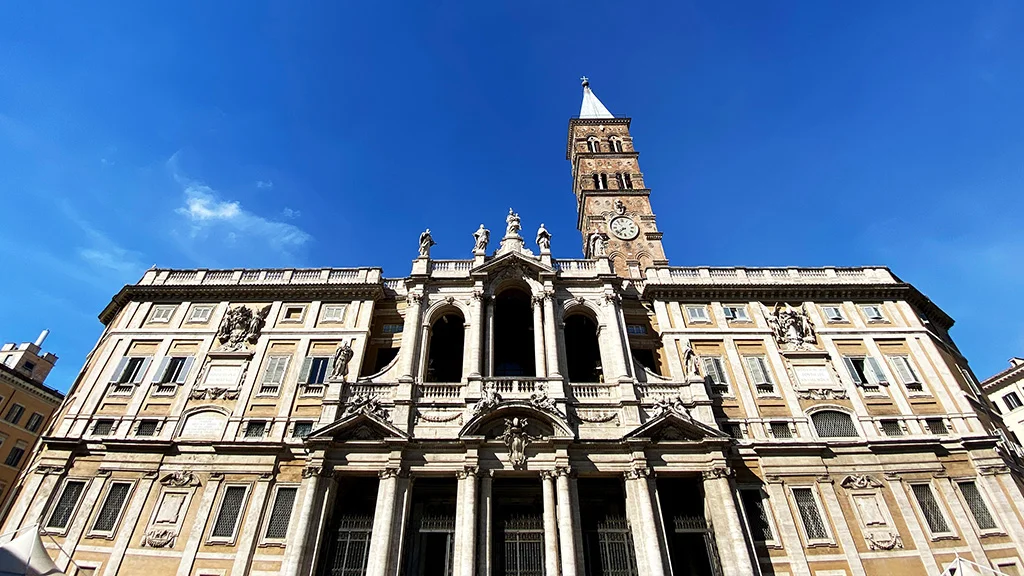 The new facade was built around the original one, meaning the beautiful mosaics that decorated it were preserved
The new facade was built around the original one, meaning the beautiful mosaics that decorated it were preservedThe Column in the Piazza
The Column of Peace (Colonna della Pace) in the piazza facing the basilica was once part of the Basilica of Maxentius in the Roman Forum.
Pope Paul V had it placed here in 1614, not long after he had also commissioned the Pauline Chapel.
He had architect Carlo Maderno design the fountain at the base of the column, and a statue of the Virgin Mary and Jesus was added on top too.
The Obelisk
The obelisk at the back of the basilica was moved there in 1587 when Pope Sixtus V had the area around the basilica reworked by his favorite architect Domenico Fontana.
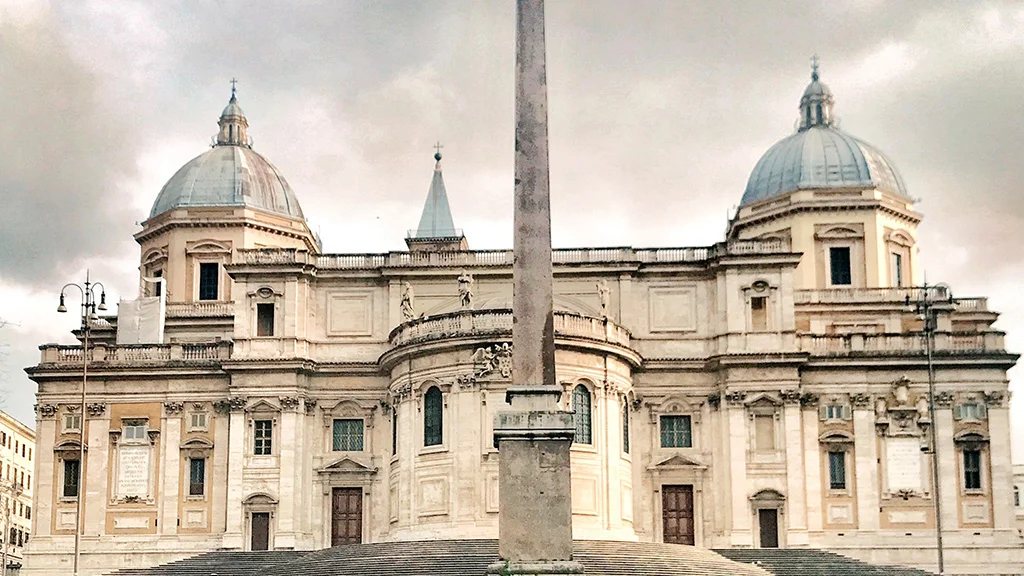 This is one of two ancient Egyptian obelisks that once stood at the entrance of the Mausoleum of Augustus
This is one of two ancient Egyptian obelisks that once stood at the entrance of the Mausoleum of AugustusThe simple obelisk made of Egyptian granite originally stood at the entry of the Mausoleum of Augustus.
Ready to plan your trip?
Book your train
Planning to travel between cities in Italy and other parts of Europe?
Use Trainline to see all the different options available across the different rail companies.
Find your hotel
Find your perfect place to stay in Rome.
Use Booking.com to choose between hotels, guesthouses, and self-catering apartments in neighborhoods throughout the Eternal City.
Buy your TurboPass
Purchase the convenient Turbopass and visit all of Rome's top attractions including the Colosseum, Pantheon, and Vatican.
With one handy pass, it's all included.
Special Things to See and Do at Santa Maria Maggiore
It's easy to just visit Santa Maria Maggiore, walk around and soak up the scenery.
It's a massive church with many things to see at every turn, so you can simply enjoy the view and that's that.
But if you have time, I suggest you explore some of the most important and interesting aspects of the basilica:
The First Nativity Scene
In Christmas 2021, a group of small marble statues sculpted by Arnolfo di Cambio in the late 13th century was put on display.
They were created for the Basilica of Santa Maria Maggiore but were put into storage after internal changes.
While this was not the first depiction of the nativity, it is the first that was inspired by Saint Francis of Assisi.
The saint created a living nativity scene in 1223, which proved very popular and shaped the way we think of nativity scenes today.
Salus Populi Romani Icon
Another important Christian artefact in Santa Maria Maggiore is a painting of the Virgin Mary and Jesus as a child, known as the Salus Populi Romani (Salvation of the Roman People).
Tradition had it that the painting was done by Saint Luke the Evangelist, making it an exceptionally holy icon.
Multiple popes have prayed in front of the painting to ask for assistance and protection.
Most recently, Pope Francis had the icon brought to St Peter's Basilica in March 2020 to pray for an end to the Covid pandemic.
Pope Francis would also visit Santa Maria Maggiore before every apostolic journey he took to ask for protection for the people he was visiting, coming back on his return to give thanks.
Originally placed above the door to the baptistery in the basilica, now the painting is located above the altar of the Pauline Chapel.
Relics in Santa Maria Maggiore Rome
There are many relics spread throughout this church.
You won't want to miss a closeup viewing of a piece of Jesus' crib supposedly brought here from Bethlehem in the 7th century.
You can view this relic by going down a small staircase to the confessio just underneath the high altar.
It's a fairly easy space to access and not claustrophobic - if I can do it, so can you.
Mosaics in Santa Maria Maggiore
There are three main places to look for mosaics in Santa Maria Maggiore; the nave, the triumphal arch and apse, and the outer façade.
When the basilica was built in the 5th century, the upper part of the nave was lined with mosaics representing Old Testament events such as Moses leading the Israelites out of Egypt.
These mosaics are mostly intact and even if they are sort of small and hard to see from the floor level, they are spectacular.
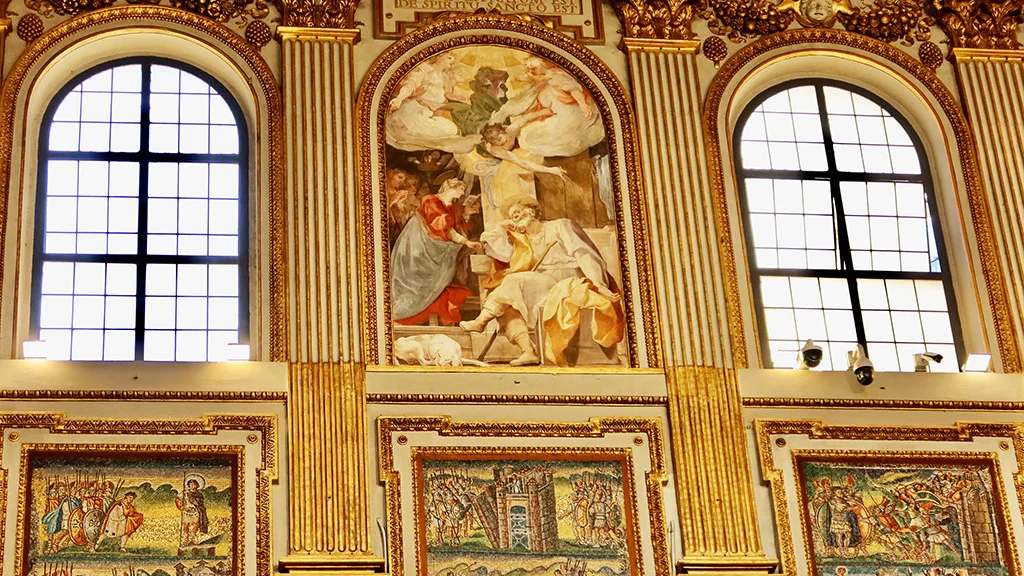 These mosaics are a bit tough to see but they are almost all the original ones from the 5th century so use your phone to see them better
These mosaics are a bit tough to see but they are almost all the original ones from the 5th century so use your phone to see them betterThen there are the 13th century mosaics in the apse by Franciscan friar Jacopo Torriti.
These show scenes from Mary's life and Jesus' childhood.
The mosaics on the original façade of the loggia are from the late 13th century, the same period as the apse mosaic.
These were both added as part of a restoration by Pope Nicholas IV.
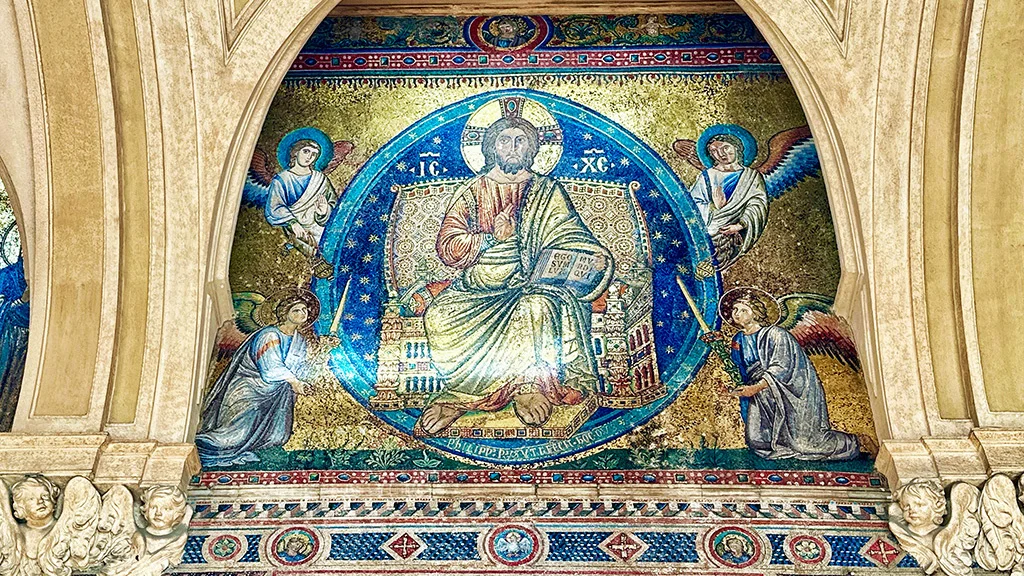 The mosaics in the loggia were once the facade of the basilica but are now protected from the elements
The mosaics in the loggia were once the facade of the basilica but are now protected from the elementsThe lower set of mosaics seem to have been executed by a different artist as they are a different style.
These show scenes from the foundation legend of the dream and the snow.
Visit Other Parts of the Basilica Complex
In addition to the basilica and its chapels, there are a few more places to explore which I suggest not missing.
First is the museum of the basilica, with rooms holding a mixture of ecclesiastical items such as clothing, decor and furniture and art.
The museum tells the story of the basilica and its most important contents - this is where the marble nativity scene is displayed currently.
You can also visit the archeological area underneath the basilica, where there are ancient Roman ruins showing what was here originally.
There are ancient mosaics, frescoes and parts of a bath complex, as well as a special calendar for agricultural work.
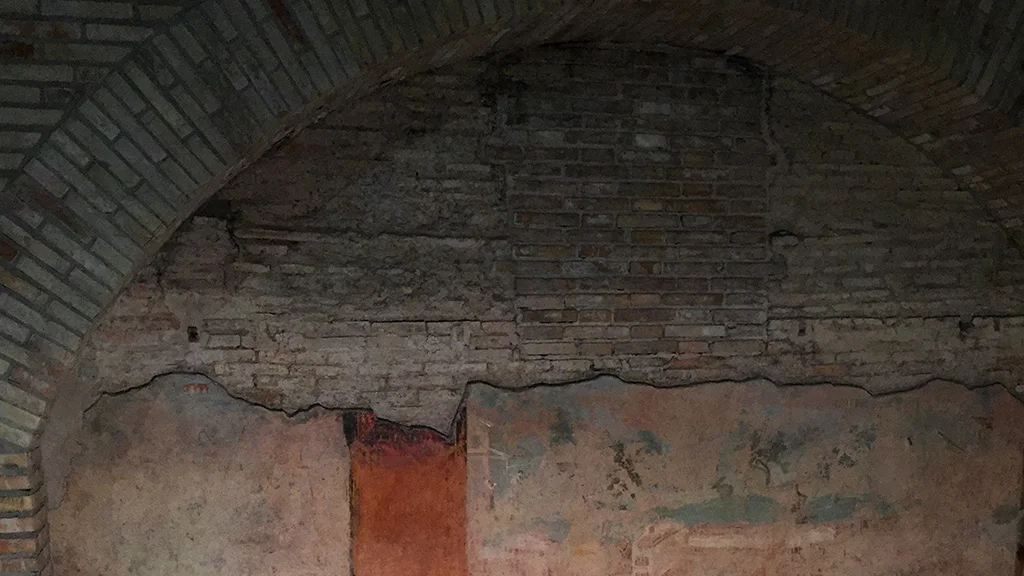 The ancient ruins you can visit as part of the museum demonstrate how nothing in Rome is not built on layers of older history!
The ancient ruins you can visit as part of the museum demonstrate how nothing in Rome is not built on layers of older history!The other part that can be visited with a tour is the upper loggia, the Hall of the Popes and a special spiral staircase.
In the loggia you can get up close to the shimmering mosaics that depict the legend of the miraculous snowfall.
You can also take a look at Bernini's hidden spiral staircase, although actually it's probably not by Bernini!
You can't go up or down it as the staircase is inside the quarters of the monks who live there, but I find it fun to see.
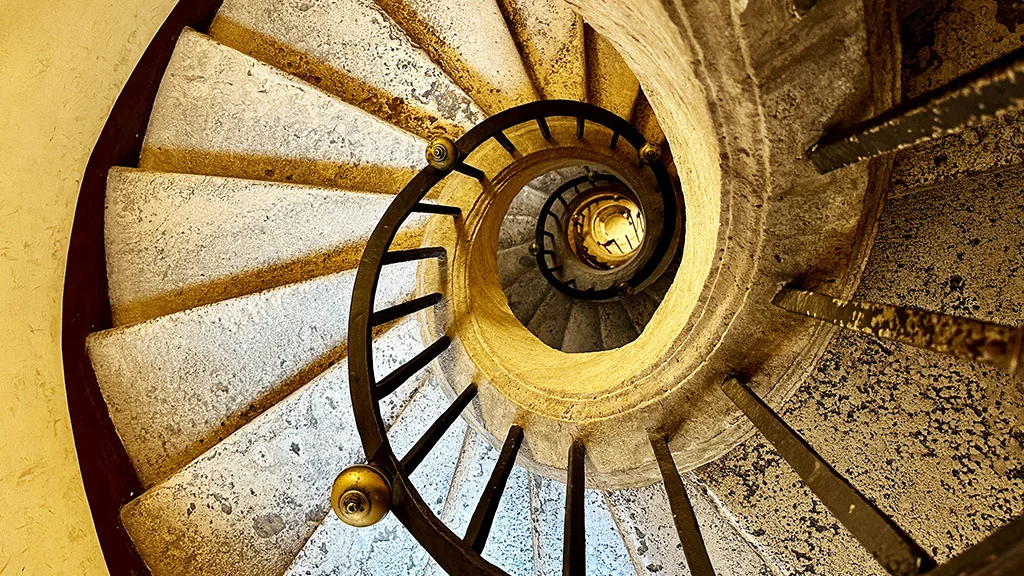 The simple but beautiful spiral staircase was supposedly designed by Gian Lorenzo Bernini, but even if it wasn't, it's still interesting to see
The simple but beautiful spiral staircase was supposedly designed by Gian Lorenzo Bernini, but even if it wasn't, it's still interesting to seeBurials in Santa Maria Maggiore
Probably the most renowned person to be interred in the basilica of Santa Maria Maggiore is the man who was lived right nearby, Gian Lorenzo Bernini.
His family was closely connected to the basilica, with other members buried here also.
At his request, there is no elaborate tomb but rather a simple tombstone slab on a step to the altar.
I never miss the chance to take a moment to say thank you for his amazing legacy when I visit.
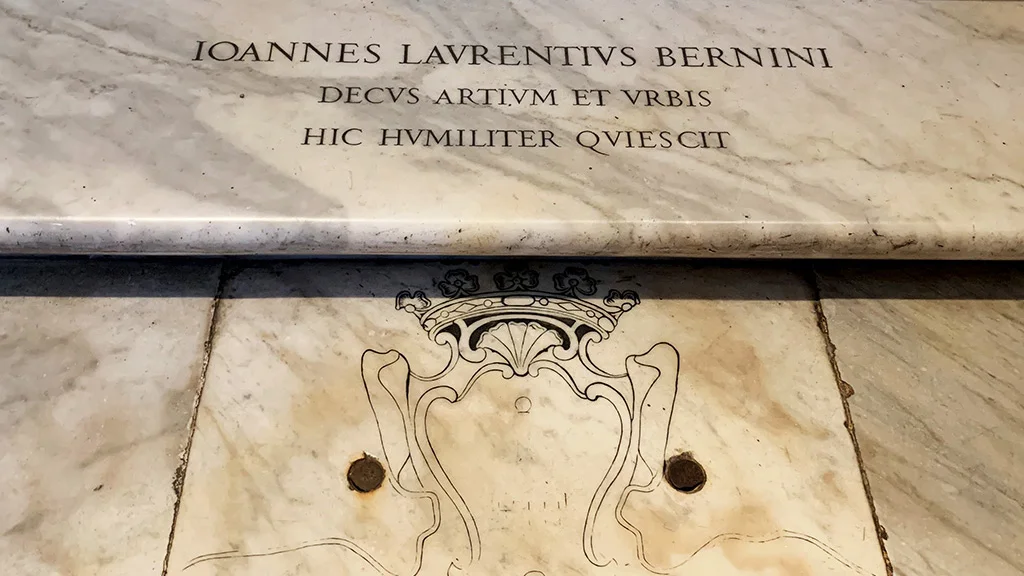 Just to the right of the main altar is the tomb of the great Baroque artist and architect, Gian Lorenzo Bernini
Just to the right of the main altar is the tomb of the great Baroque artist and architect, Gian Lorenzo BerniniAnother famous person who you might be surprised to find is buried here is Pauline Bonaparte, younger sister of the famous Napoleon who married a Roman Borghese prince.
The Sistine Chapel
Several popes are buried in Santa Maria Maggiore, including, perhaps most famously, Pope Sixtus V, who has a whole chapel named for him, the Sistine Chapel.
The word "Sistine" refers to the papal name "Sixtus" - the other, much more famous Sistine Chapel, was named for Pope Sixtus IV.
Added to the basilica in the 1580's, the chapel was the largest in Rome at the time.
Home to the funerary monuments of Pope Sixtus V and Pius V, the chapel itself is stunning.
The paintings on the walls show scenes from the Bible but I particularly love the central altar.
On the shoulders of four bronze angels sits a small copy of the chapel itself, making the altar a mini chapel - so clever!
The Pauline Chapel
In the chapel opposite you will find the Pauline Chapel, built in 1611.
It is named for Pope Paul V, a Borghese pope who contributed a lot to renovations in this basilica.
The whole chapel is lavishly decorated with mosaics, frescoes, marble and precious stones, as well as a beautiful dome.
However the main focus is the elaborate frame for the Salus Populi Romani painting on the wall above the altar.
Inside the Pauline Chapel is a crypt for the Borghese family, where Pope Paul V is buried here.
He also had the remains of his predecessor Pope Clement VIII moved here from Saint Peter's Basilica.
The Sistine Chapel is often open for visits, whereas the Pauline Chapel is usually only open for prayer.
No photos are allowed in the Pauline Chapel.
Michelangelo's Sforza Chapel
Most people don't realize that there is a bit of Michelangelo in this basilica.
On the left-hand side, just before the Pauline Chapel, you can see the outside of the Sforza Chapel, designed by the great artist for two Sforza brothers' mausoleum.
It's only open occasionally for prayer but you can peer inside.
Pope Francis' Tomb
On Saturday April 26, 2025, Pope Francis took one final journey from St Peter's Basilica to Santa Maria Maggiore.
After the huge public funeral in St Peter's Square, he was buried in a private ceremony in the tomb prepared for him here.
He visited the basilica 126 times as pope, as well as many times in the years before as a priest and then cardinal.
This close connection led to the somewhat unusual choice of the basilica for his final resting place, Francis being the first pope to choose burial outside of the Vatican in over 120 years.
His tomb is simple but affecting, with only 'Franciscus' carved into the stone slab.
To date, tens of thousands of people have queued to pay their respects at his tomb, and many more are expected to come.
Preparations in place for the Jubilee pilgrims visiting have been adapted in light of this, so if you are visiting the basilica soon, expect some queuing and heightened security measures.
Photos at the tomb are not allowed currently - it is not clear if this is a temporary crowd control measure or a permanent decision however.
Practical Visit Information
The Basilica is open daily from 7AM to 7PM, with last entry at 6:30PM.
The museum and additional areas are open Monday-Saturday 9:30AM to 6:00PM, with last entry at 5:30PM.
Masses are held regularly in the main basilica and Pauline Chapel - find out the current timings and schedule on the official website here.
On the official site you will also find details of the celebrations for Christmas, Easter and more.
Santa Maria Maggiore Rome Location
Santa Maria Maggiore is near Termini station at the intersection of via Merulana and via Cavour in the Esquilino neighborhood, on the edge of the Monti neighborhood.
You can easily reach the basilica via Metro lines A or B at Termini train station, as well as many buses that stop nearby.
It's only a 5-10 minute walk from there.
It will open in a new window.
Romewise's Top Travel Resources
Ready to book your trip to Rome? Take a look at these helpful links to companies we use and trust:
- Keep your travel spending simple with the Wise card, which removes all the worry about exchange rates and high transaction fees all over the world
- Search for and book your perfect accommodation
- Our complete guide to what to pack for Rome
- The number one travel accessory, a multi-point travel adapter and voltage converter
- Browse a huge range of tours in Rome and beyond
- Experience unique tours and special access to Rome's most popular sights
- Protect yourself with comprehensive travel insurance
Within this post there are some affiliate links for products and services. For more details about our affiliate policy click here.
Get your 100% free Rome trip planner now!
Simply sign-up today for our free newsletter and get the Romewise Quick Start guide to Rome:
We are committed to respecting your data. Click for our Privacy Policy.
Comments? Questions? Suggestions?
Please come over to the private Romewise Facebook group and join in the conversation.
You will often find me there, happy to answer your questions / comments!
You will also meet other Rome lovers and experts, too.
What are you waiting for?
- Romewise Home Page
- What to Do in Rome
- Santa Maria Maggiore Rome

